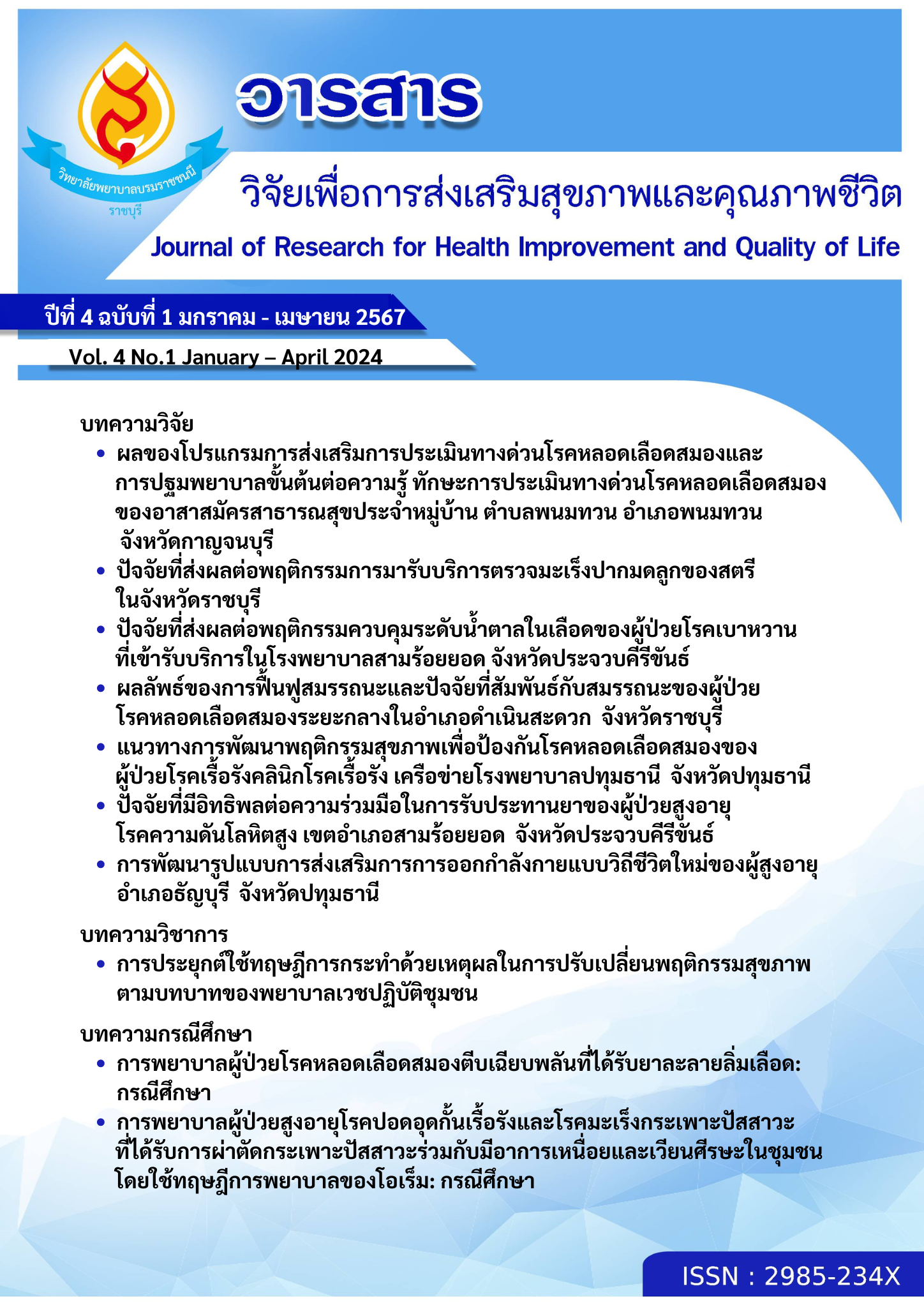การพัฒนารูปแบบการส่งเสริมการการออกกำลังกายแบบวิถีชีวิตใหม่ของผู้สูงอายุ อำเภอธัญบุรี จังหวัดปทุมธานี
คำสำคัญ:
การออกกำลังกาย , วิถีชีวิตใหม่ , ผู้สูงอายุบทคัดย่อ
งานวิจัยนี้มีวัตถุประสงค์เพื่อ 1) ศึกษาสภาพและความต้องการให้สนับสนุนในการออกกำลังกายแบบวิถีชีวิตใหม่ของผู้สูงอายุ 2) พัฒนารูปแบบการออกกำลังกายและเปรียบเทียบผลการทดลองใช้รูปแบบการออกกำลังกายแบบวิถีชีวิตใหม่ของผู้สูงอายุต่อระดับสมรรถภาพทางกายเก็บรวบรวมข้อมูลแบบสอบถามจากผู้สูงอายุ 350 คน และทดลองใช้รูปแบบการออกกำลังกายแบบวิถีชีวิตใหม่ของผู้สูงอายุ จำนวน 27 คน ผลการศึกษา พบว่า
1. ความต้องการด้านบุคลากรผู้ให้บริการ มีค่าเฉลี่ยอยู่ในระดับมาก (M= 01, SD = 0.94) ความต้องการด้านสถานที่ อุปกรณ์ และสิ่งอำนวยความสะดวก มีค่าเฉลี่ยอยู่ในระดับมาก (M= 3.93, SD = 1.04) และความต้องการด้านการส่งเสริมและให้ความรู้ในการออกกำลังกาย มีค่าเฉลี่ยอยู่ในระดับมาก (M =3.80, SD =1.08)
2. ระดับสมรรถภาพทางกายของผู้สูงอายุภายหลังการใช้รูปแบบฯ ประกอบด้วย ค่าเฉลี่ยของการทดสอบการลุกจากเก้าอี้ การงอข้อศอก การยกขาสูง 2 นาที และเดินเร็วอ้อมระยะ 2 เมตร ดีขึ้นกว่าก่อนการเข้าทดลองอย่างมีนัยสำคัญทางสถิติที่ระดับ 0.05
ดังนั้นควรส่งเสริมส่งเสริมรูปแบบการออกกำลังกายแบบวิถีชีวิตใหม่สำหรับผู้สูงอายุเน้นไปที่การพัฒนาโปรแกรมหรือกิจกรรมที่เหมาะสมสำหรับกลุ่มนี้ และการสร้างแนวทางการกระทำที่สามารถนำเสนอให้กับชุมชนหรือองค์กรที่ดูแลผู้สูงอายุ
เอกสารอ้างอิง
Aumnug, B. (2020). Principles as an athletic trainer. Institute of Physical Education Suphanburi Campus.
Cohen, J. (1977). Statistical power analysis for the behavioral sciences (Rev. ed.). Lawrence Erlbaum Associates, Inc.
Dawes, J. (2008). Do data characteristics change according to the number of scale points used? An experiment using 5-point, 7-point and 10-point scales. International Journal
Department of Elderly Affairs. (2021). Statistics and trends of the elderly in 2013 - 2030. http://www.dop.go.th/download/laws/law_th_20152309144546_1.pdf.
Department of Physical Education. (2017). Activity needs, needs, and expectations recreation of the public who use the sports, recreation and science learning centers. Sports under the Department of Physical Education (in Thai)
Gavilbun, S. (2017). Factors related to physical activity habits of the elderly. Social Sciences Journal, 7(3), 161-173. (in Thai)
Institute for Population and Social Research. (2022). Situation of the Thai Older Persons 2021. https://ipsr.mahidol.ac.th/post_research/situation-of-the-thai-older-persons-2021/
Karuhadej, P., Dangthongdee, S., Changchenvate, C. Maungtoug, N., & Rakkarn, J. (2019). Perceived exercise behavior in people who exercise. Guy at Bangkok Park. Vajirawej Journal, 63(6), 455-466.
Krejcie, R. V., & Morgan, D. W. (1970). Determining sample size for research activities. Educational and Psychological Measurement, 30(3), 607-610.
Kulthawatvichai, T. (2016). Principles of Sports and Exercise Management. Faculty of Sports Science, Chulalongkorn University. (in Thai)
Muenya, S. (2020). The effectiveness of family support on behavior Exercise of the elderly. The journal of Faculty of Nursing Burapha University. 25(1), 4-12. (in Thai)
Songvut, P., Srimuang, P., & Tudpor, K. (2020). Fall prevention by Otago exercise program based on health belief model in community-dwellingolder persons. Indian J Physiother Occup Ther, 14(1), 245-524.
ดาวน์โหลด
เผยแพร่แล้ว
ฉบับ
ประเภทบทความ
สัญญาอนุญาต
ลิขสิทธิ์ (c) 2024 วิทยาลัยพยาบาลบรมราชชนนี ราชบุรี

อนุญาตภายใต้เงื่อนไข Creative Commons Attribution-NonCommercial-NoDerivatives 4.0 International License.
บทความทีตีพิมพ์ในวารสารนี้ถือว่าเป็นลิขสิทธิ์ของวิทยาลัยพยาบาลบรมราชชนนี ราชบุรี และผลงานวิชาการหรือวิจัยของคณะผู้เขียน ไม่ใช่ความคิดเห็นของบรรณาธิการหรือผู้จัดทํา




